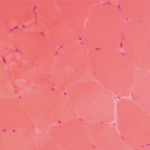Håkan Westerblad, PhD, professor of cellular muscle physiology at the Karolinska Institute in Sweden, who for 30 years has studied what happens to muscles when they fatigue, said this understanding seems to be leading to potential treatments.
“With the same size, muscle fibers from an RA patient produce less force,” he said. “There is an intrinsic problem inside the muscle fibers.”
Through a series of studies, researchers at Karolinska Institute have found that in mouse models of RA and in RA patients, decreased force is related to increases in reactive oxygen/nitrogen species or free radicals. The muscles in RA patients, they found, have more neuronal nitric oxide synthase (nNOS), which means more production of the free radical, nitric oxide. At the same, these muscles also have decreased levels of superoxide dismutases (SOD2), which metabolizes the reactive oxygen species superoxide.
The combined increase in nitric oxide and superoxide then leads to the accumulation of a highly reactive molecule—peroxynitrite, or ONOO—that can change the function of proteins inside cells.
Dr. Westerblad said the rise in nNOS as such is probably not the real problem.
“It’s also that it moves,” he said. In this case, nNOS sits on the ryanodine receptor complex, a critical protein complex that controls how much calcium is being released inside cells during muscle contraction. This has been observed in both slow-twitch and fast-twitch muscles, Dr. Westerblad said. “It seems to move in all of them,” he said.
The effect of these radicals was a little bit surprising.
“Calcium release is not actually decreased; it’s rather increased, so you have an increased calcium release in the muscles cells” he said. “Calcium is needed for proper contraction,” he said, “but on the other hand, it’s sort of playing with fire, because too much calcium in the wrong place is not very good either.”4
Looking further, researchers found that the weakness itself is likely brought about by 3-NT or 3-nitrotyrosine, binding to actin. If myosin is the motor of the muscle, then actin is “the rope, in a way, that the motor is pulling,” Dr. Westerblad said. If the function of actin is disrupted, weakness can occur.
In a study accepted for publication in Skeletal Muscle, researchers have found that this process of weakening can be prevented, in an RA rat model, with treatment with the antioxidant EUK 134.5
“If we treat them with the antioxidant EUK 134, they completely recover their force production,” Dr. Westerblad said. But researchers also found that knee swelling was not affected by this treatment, indicating that there are separate mechanisms at work.



